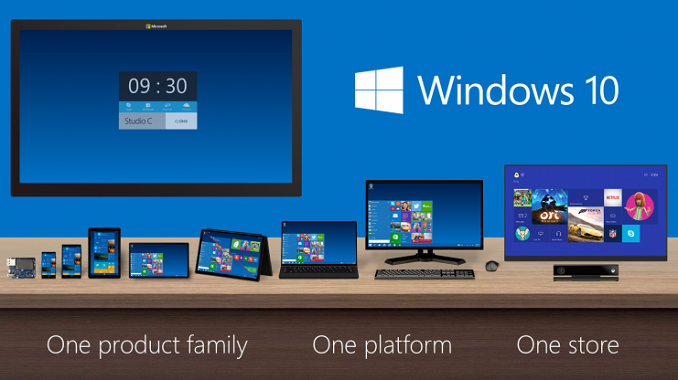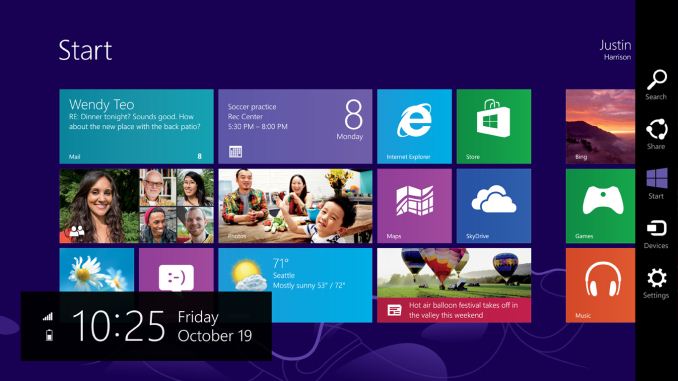Windows 10 Technical Preview First Impressions: The Return Of The Desktop
by Brett Howse on November 13, 2014 8:00 AM EST- Posted in
- Software
- Microsoft
- Windows 10

I’ve said this before, and I will reiterate it now. Windows 8, in general, is not perceived in a positive light. Not necessarily because of the lack of features, or even due to the touch first interface, but because from the start people did not buy into the paradigm. We can argue over why that was, and the specifics are likely different for every individual. But a big part of that was that Windows, which has had a familiar interface since Windows 95, had changed dramatically in look, feel, and general use. The traditional mouse and keyboard PC and notebook is a big part of the Windows user base, and especially at the beginning, Windows 8 did not cater to that crowd. While there were certainly improvements to the desktop, it was not enough to overcome the negative feelings of many users in regards to being productive on their PC. I say this as a fan of Windows 8.1, and I say this despite the positive review from this site. Windows 8 was an OS that worked, but had a steep learning curve that many people did not want to bother learning.
One of the biggest issues facing Windows 8 was just how much people liked Windows 7. Windows 7 was seen as the savior to Vista, and fixed many of its issues. But a lot of the initial problems with Vista were due to a major change in the driver model as well as the security model, which caused a lot of compatibility issues with older programs which expected administrator rights, as well as many hardware devices needed driver updates. With Windows 7, all of those changes were in the rear view mirror, allowing 7 to be a tweak of the overall UI and functionality rather than a rebuild of the OS from the ground up. With Windows 8, the move to touch first caused another dramatic upheaval. This time, rather than incompatible programs and hardware, we got a new Start Screen, a new runtime in WinRT, and a new app model with the Windows Store. For reasons that will never be made clear, the familiar start button was even removed, with the designers relying on hidden functions such as the hot corners to navigate around the OS with a mouse and keyboard. Luckily this change was reversed for Windows 8.1, with the start button returning, even if it still opened the Start Screen. With the Windows 8.1 Update, the system was made much more usable for a mouse and keyboard with the return of the menu bar to close apps, rather than dragging them down off the screen, and several other changes as well which brought the balance back somewhat to cover both touch interfaces as well as the mouse and keyboard.
 Windows 8 at launch in October 2012
Windows 8 at launch in October 2012
With Windows 8, Microsoft tried out an operating system which would work with a single interface across a breadth of hardware, from small form factor tablets, up to 30” monitor desktops. While they certainly succeeded in creating an interface that worked across all of those platforms, it was not ideally suited to any of them. With the tablet mode, the new Start Screen worked very well, and the charms menu and app switcher were fairly easy to use. But many of the settings and programs would be on the desktop, where touch only worked sparingly. Some desktop applications, such as Office, were created with a touch mode to increase the size of the onscreen elements, but overall the experience was subpar. Similarly, on the desktop, the touch interfaces were not ideal, and the hot corners certainly had issues especially on multi-monitor systems.
Windows 10 Technical Preview at launch
But now we come to Windows 10. Windows 10 is ditching the “One Interface to Rule them All” mentality, and moving to a more user friendly model of a single store across all platforms, and multiple interfaces to the same OS depending on the current usage model. We have not seen all of this in practice as of yet in the Technical Preview, but Microsoft has demonstrated their solution to this change in input mode with a feature they are calling Continuum.
The goal is that those that are on a keyboard and mouse based system will have the traditional start menu and desktop, with apps in windows, but if you are on a touch based device, or if you go on a 2-in-1 from keyboard to touch, the system will switch to the Windows 8 style start screen with full screen apps.
One of the keys to having this experience is an app model that allows a developer to target this different user interface paradigms. Microsoft’s solution to this is Universal Apps.











198 Comments
View All Comments
inighthawki - Friday, November 14, 2014 - link
The two are very orthogonal. If you think more monitors replaces virtual desktops, then you clearly don't understand the purpose for virtual desktops at all.Multiple monitors are about multitasking in a single scenario. e.g. I can have visual studio open on one monitor while a web browser shows documentation for the API I'm using on another, Virtual desktops is about separation of unrelated scenarios. One virtual desktop may have work related tasks and programs open (e.g. outlook, word, visual studio), while another virtual desktop has personal stuff (e.g. web browsing, netflix).
I also work in a programming environment where I work on enlistments of projects simultaneously (i.e. different views of the same source repository). Being able to have one enlistment per desktop is an excellent separation of data that I'm greatly looking forward two while using my multi-monitor setup at work.
Donkey2008 - Wednesday, November 19, 2014 - link
"One virtual desktop may have work related tasks and programs open (e.g. outlook, word, visual studio), while another virtual desktop has personal stuff (e.g. web browsing, netflix)"That's the best explanation of v-desktops I have heard so far. Common users will understand that without confusing tech mumbo jumbo talk.
TEAMSWITCHER - Saturday, November 15, 2014 - link
So what you're saying is that Microsoft has trouble implementing even 1990's era technology? I see your point.name99 - Saturday, November 15, 2014 - link
"now a days we have dual / tri/ quad monitor setup. works much much better."Nowadays? I used a setup of three 19" (CRT) monitors when I worked at Apple, starting from about 1992...
Two primary use case for virtual desktops, at least in the case of OSX are:
- laptops
- HTPCs (where virtual desktops are perhaps not essential, but they come along for the ride when you full screen an app, and many people use multiple video viewing apps)
In both these cases the whole POINT is that multiple hardware screens are not really a sensible option.
Gigaplex - Friday, November 14, 2014 - link
"Windows 10's implementation as it exists today has jarring transitions with no ability to move windows between desktops or change the rearrange the desktops."It is hidden, but you can move windows between desktops.
inighthawki - Friday, November 14, 2014 - link
I think it's also safe to say that this is a tech preview (i.e. a beta) so there's probably more left to do.milkod2001 - Thursday, November 13, 2014 - link
First slide on top has text: One product family, One platform and One Store with MS w10 logo(some MS exec has probably spent 5 min. designing that using Word and thought it' cool :)Will any x86 desktop app work on windows smartphone or tablet as slide indicates? Or at least all new apps from MS store will work 100% across all platforms?
Overall Windows 10 looks very promising.I have to give MS team credit for bringing start button back(it only took them 2 years), beautiful tiles are still there with quick access to all trends, FB, Twitter is there as well, some nice pictures and lets not forget MS Store if you want to buy some fantastic App...
Gigaplex - Friday, November 14, 2014 - link
Desktop apps will not work on phones. Only WinRT ("Metro") apps work on all platforms.name99 - Saturday, November 15, 2014 - link
" One product family, One platform and One Store"Microsoft's attitude to this is beyond retarded. On even numbered days they trump this "one, one, one" to the skies; on odd numbered days they assure us loudly that that is past, that now they care about the best UI and best code for every distinct platform.
The way they are treating this bears all the marks of a company that doesn't have a clue what it's strategy REALLY is. Satya either can't make up his mind on this, or he HAS made up his mind, but he can't get half the company to go along with what he has said...
Xajel - Thursday, November 13, 2014 - link
The thing I'm missing is the way a Microsoft account works, It will use the email, password, the full name registered in the account... and I can't change these without affecting my MS account... I hate that and I like to use my nickname rather than my full name, and a different password than my MS account password.. not to mention I don't like to see the name/email in the c:\users\NAME